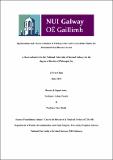| dc.description.abstract | Polypropylene mesh was created by Usher in 1962 after he experienced unsatisfactory
results from using autografts and allografts for hernia repairs. More than fifty years later,
polypropylene is still the most popular hernia mesh in use today. More recently, biologic
meshes were introduced for their ability to integrate and be replaced with natural host tissue,
and ability to resist infection. From a humble, and perhaps doubtful beginnings, biologic
meshes are now accorded a category of their own to meet the needs of both routine as well as
the very complex reconstruction. However, over-enthusiastic use of these biologic meshes
has resulted in implant stretching, abdominal bulging and hernia recurrence.
The work described in this thesis focuses on the development of a crosslinked
extracellular matrix for abdominal wall repair, with the aim of eliminating unfavourable early
biomaterial degradation in vivo. This project centred on the characterisation and optimisation
of cholecyst-derived extracellular matrix (CEM), a novel biomaterial discovered by this
group. The key hypothesis of this work was that a slowly degradable, crosslinked CEM with
optimised degradation profile would improve tissue response and clinical outcome in hernia
repair, in particular, reducing implant area stretching and bulging.
In the first phase of this work, CEM decellularisation and its composition was
established, followed by development of crosslinking strategies. CEM has a loose randomly
arranged, mesh-like fibrous matrix network on SEM. Glutaraldehyde crosslinking of CEM
resulted in reduced susceptibility to collagenase enzyme degradation in vitro. The degree of
crosslinking was characterised for physiochemical, mechanical and degradation studies, in
addition to cell culture studies. However, glutaraldehyde-crosslinked CEM was associated
with very poor cell attachment and proliferation, due to the well-known toxicity effects of
glutaraldehyde. In the second phase, an alternative crosslinker using the carbodiimide system
(EDC/NHS) was chosen as the molecule does not incorporate itself within crosslinks (zerolength
crosslinker), is water soluble and does not leave any cytotoxic residues in the
substrate. The extent of crosslinking was controllable and an optimised method established.
Furthermore, cell culture studies showed that cell viability was maintained and cells
proliferated on the EDCxCEM crosslinked scaffolds with normal cell morphology.
Subcutaneous implantation study in rats was carried out to evaluate in vivo degradation
profile and host response of EDCxCEM.
XXIII
The third phase of this work was aimed to develop an improved in vivo model for
testing surgical meshes for abdominal wall repair. Modifications to current existing models
were made to detect implant area changes more objectively, which is either shrinkage or
stretching, seen with synthetic meshes and non-crosslinked biological meshes, respectively.
Three model implants were used to confirm the utility of our rabbit model. In parallel, a
stereological approached was utilised for quantitative analysis of histological parameters of
the implant area. Using this approach, statistical differences such as volume fractions of
residual implant, nuclei and blood vessels were used to provide supportive quantitative data
for comparison.
In the final phase, a prototype EDCxCEM implant was compared with commercially
available polypropylene, four-layer small intestinal submucosa and glutaraldehydecrosslinked
bovine pericardium in vivo. Clinical parameters including seroma rate, adhesion
formation and macroscopic changes to implant area were compared. Furthermore, host tissue
response parameters were evaluated with stereological quantification. Crosslinked
EDCxCEM showed promise due to its improved resistance to implant area stretching and
more favourable tissue response. Thus, supplementary crosslinking augments the in vivo
degradation profile and supports new host tissue formation and maturation, before critical
degradation of the scaffold. | en_IE |


